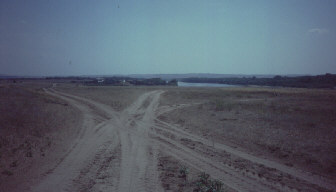
GEOGRAPHY
The Volgograd region lies in the south-east of the Southern European Plain on the rivers Volga and Don. It borders on the Saratov region to the north, on Kasakhstan to the East, on the Astrakhan region and the Kalmyk Republic to the south, to the Rostov region to the south and west and to the Voronesh region to the north-west.
The region's surface area is 113,900 km², that is, almost as large as the German states of Bavaria and Niedersachsen together. The entire territory is divided into two geographical areas by the Volga: the first of these are the flat low-lands on the left bank, while the second is the hilly "Volga-Plateau" (up to 358 m high) on the right bank of Europe's longest river. Most of the region is covered by steppes (with a variety of grasses) and semi-arid areas. Forests (oak, acorn etc.) only cover about 4% of the territory.

Roads through the steppe on the Don
river